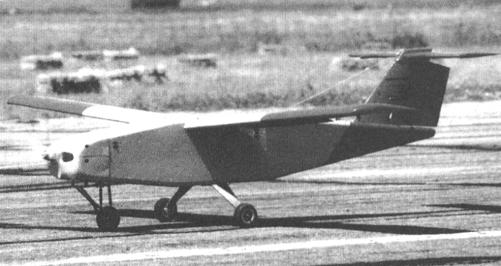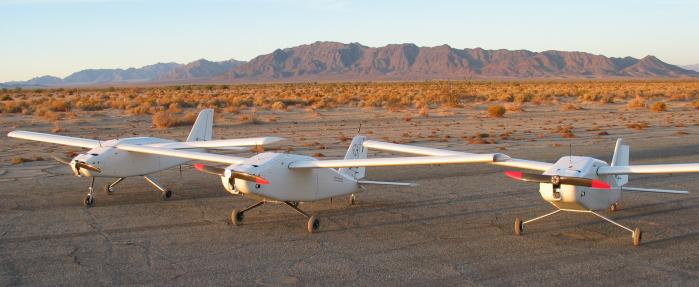Geneva Aerospace (Daedalus) Truck/Dakota
The Truck general-purpose reconnaissance/surveillance UAV was originally developed by Daedalus Research Inc., and made its first flight in August 1994. By 1997, a handful of Truck systems had been built for demonstration purposes, and two systems were operated for general research into UAV technologies by the U.S. Navy's NRL (Naval Research Laboratory). The Navy used the name Dakota for the UAV, and that appellation has since replaced the original "Truck" as the vehicle's name. In July 2001, all design rights for the Dakota airframe were acquired by Geneva Aerospace.
 |
| Photo: via Jane's |
| Dakota (Truck) |
The Dakota is a small UAV with an external shape very similar to a general utility aircraft, and is powered by a small piston engine. For conventional take-off and landing the UAV is fitted with a fixed tricycle undercarriage, but photographic evidence shows that the landing gear can apparently be changed very easily to a tail-wheel configuration. The original Daedalus Truck/Dakota had a T-tail, but the current Dakota vehicles from Geneva are slightly redesigned. They use a low horizontal tail and are quite a bit larger. The Dakota has a combined payload/fuel capacity of 36 kg (80 lb) and has an endurance of up to 6 hours. It is equipped with a general-purpose payload bay in the center fuselage. Typical payloads include daylight, low-light or infrared cameras, but other sensors and instruments can be installed as well.
 |
| Photo: Dave Duggan, Geneva Aerospace |
| Dakota |
Daedalus' original Truck vehicles were not equipped with sophisticated equipment for autonomous flight navigation, and had to be controlled from the ground. This has been significantly changed, however, because the Dakota is used by the NRL primarily to develop and demonstrate advanced UAV control technologies. In July 1998, the U.S. Navy demonstrated simultaneous control of four Dakota UAVs by a single operator, using a Northrop Grumman CAMMS (Cooperative Aggregate Mission Management System) control system.
 |
| Photo: Dave Duggan, Geneva Aerospace |
| Dakota |
Starting around 1996, Geneva Aerospace has developed their VACS (Variable Autonomy Control System) in cooperation with the USAF's AFRL (Air Force Research Lab) at Wright-Patterson AFB. VACS allows several different levels of autonomy for the UAV's flight control system, ranging from fully automatic GPS-aided navigation to full control by a ground-based operator. This technology allows a single operator to effectively control several flying UAVs at the same time while still having full authority over the mission options. Geneva's VACS/Dakota development effort eventually culminated in a demonstration in January 2003, when a single non-pilot operator used a single ground station to control and manage three UAV missions simultaneously. The tasks included transfer of UAV control from a Launch and Recovery Authority after take-off, the issuing of commands to the UAVs to perform various preplanned and/or dynamic simulated reconnaissance/strike/monitoring missions, retasking the UAVs during the missions, and re-transfer of the UAVs to the Launch and Recovery Authority before landing.
Specifications
Note: Data given by several sources show slight variations. Figures given below may therefore be inaccurate!
Data for Dakota:
| Daedalus Truck/Dakota | Geneva Dakota | |
|---|---|---|
| Length | 2.95 m (9 ft 8 in) | ? |
| Wingspan | 3.86 m (12 ft 8 in) | 4.88 m (16 ft) |
| Weight | 60 kg (133 lb) | 100 kg (220 lb) |
| Speed | 204 km/h (126 mph) | 185 km/h (115 mph) |
| Ceiling | 4570 m (15000 ft) | |
| Range | 220 km (120 nm) | ? |
| Endurance | 3 h 20 min | 6 h |
| Propulsion | Aerrow A-200 piston engine; 17.9 kW (24 hp) | Piston engine |
Main Sources
[1] Kenneth Munson (ed.): "Jane's Unmanned Aerial Vehicles and Targets, Issue 15", Jane's, 2000
[2] Geneva Aerospace Website
Back to Directory of U.S. Military Rockets and Missiles, Appendix 4
Last Updated: 31 May 2004